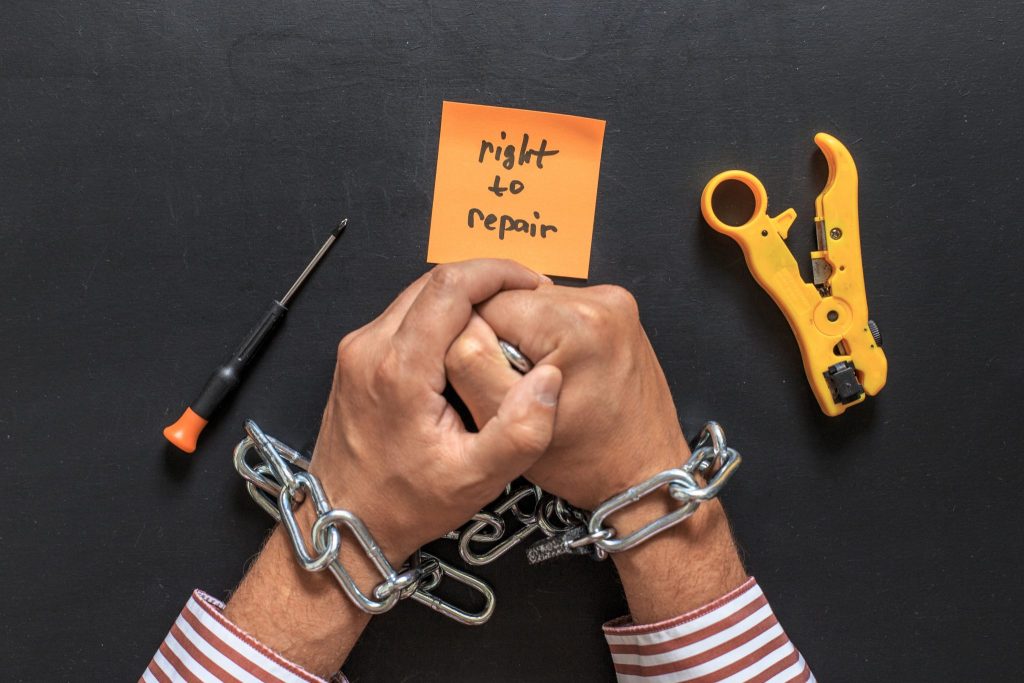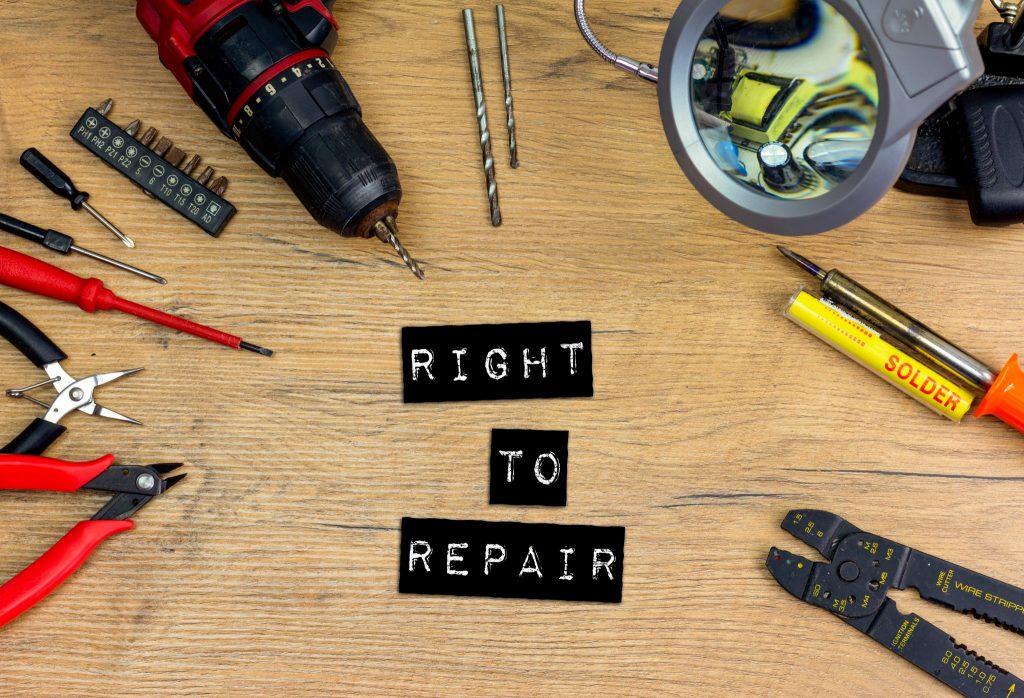I don’t live in California and I haven’t been down there very often, but I often waver between thinking the place is either right on the mark or off the wall on many issues. One issue in particular that’s garnered a lot of news lately is the growing movement toward enshrining the right to repair stuff. The movement seems to have originated among farmers who want to be able to repair broken farming equipment themselves or have it fixed by local third-party repair shops instead of having to pay the exorbitant fees that manufacturers of such equipment charge for such services. A lobbying organization has been set up in the USA to help propel the movement forward, and up here in Canada a Member of Parliament of the Province of Ontario has submitted a bill proposing legislation that allows consumers to have the legal right to repair the devices they’ve purchased. The European Union is also considering strengthening legislation in this area, in particular to address the growing problem of tech waste or e-waste (although broken dishwashers seem to be more of a problem over there).

Right to repair not right for Apple
Apple has opposed such legislation in the past and has lobbied in various jurisdictions to kill any proposed legislation that would make it easy for users to repair their broken iPhones and other devices, though they have begun making some small steps towards this direction. But U.S. state initiatives to introduce right to repair legislation continue to gain ground, and in all the hurry and rush it might be worthwhile for us to pause for a moment and ask ourselves whether such initiatives will help us as consumers or end up harming us instead.
The big elephant in the room, of course, is greed. With a market capitalization of about $900 billion as of late March, you’d think Apple would have the grace to let go of a few bucks in their revenue stream and provide consumers with the technical guidance and parts they need to repair their iPhones and other devices without having to find a nearby Apple store and pay for a Genius to help them. But $900 billion is a serious drop from the $1 trillion market cap Apple hit a bit more than six months ago, so I guess Captain Cook and his gang of pirates feel it’s necessary to continue to crank out products that can’t easily be repaired and need to be replaced every couple of years. Still, greed is the American way in many respects, so one can’t really be surprised by the way Apple operates. (Full disclosure: I’m a Canadian.)
But let’s say that the right to repair movement wins the current conflict and legislation to this effect gets enshrined by federal, state and provincial governments here in North America. Does this mean that we as consumers can celebrate that we’ve won?
Not necessarily. If you look into some of the right to repair legislation closely you’ll discover things like rules requiring companies that manufacture devices like smartphones to keep making parts for phones they no longer manufacture. In some cases proposed legislation would require companies like Apple to continue making parts available for iPhone models up to seven years after the models themselves are no longer being manufactured. Changes like this would necessitate a complete retooling of the company’s manufacturing processes, and it could cost they would incur doing this could be huge. And guess who will ultimately have to bear the brunt of these costs? Us consumers.

More problems
Then there are proposals in such legislation that would require manufacturers to allow third parties to make and sell replacement parts for the devices they manufacture. Now really, does that sound like a good idea to you? Take that most exasperating but necessary part of today’s laptop or smartphone: the battery. While most of the parts used to make iPhones and other devices are manufactured in China by companies under license to Apple, there are also a ton of Apple-clone parts out there being manufactured and sold by unlicensed Chinese companies, many of which are shady. (I encourage you to read Paul Midler’s book “Poorly Made in China: An Insider’s Account of the China Production Game” if you have any doubts about this area. His earlier book “What’s Wrong with China” is even more disturbing — or hilarious, depending on how you see things.) With batteries this can be a real problem because Lithium ion batteries can be prone to exploding if they’re not manufactured properly according to strict industrial standards. And I think the last thing you want to have happen to you is to have your iPhone blow up in your hand because you had a local repair shop replace the battery in your phone with one made by someone other than Apple. And requiring Apple itself to continue manufacturing batteries for iPhones years after the phones themselves are being manufactured or sold is also problematic because lithium ion batteries have a limited shelf life when they’re not being used.
There’s also another problem which has to do with the security and privacy of your devices. Many of us who own Macs and iPads have felt we needed longer Lightning cables than the ones that came with our tablets, and to save money we bought such cables on Amazon instead of from Apple. Well, recently a security researcher demonstrated you can actually hide a WiFi chip inside a Lightning cable and use it to gain control over a Mac you plug the cable into. Now I wonder how long it will be until cables like that show up on Amazon Marketplace sites? What I mean is that by passing legislation that requires manufacturers to release detailed technical documentation of their devices so third-party companies can manufacture compatible parts and repair shops can undertake repairs with these parts, legislators who appear to have our best interests at heart as consumers may actually be facilitating the spread of malware that can compromise the security of our tech gear and eavesdrop on our private communications.
My point in all this is to simply point out that legislation can often break as many things as it tries to fix. So maybe it’s time we all took a breath and reconsidered the scope of what the right to repair movement is trying to accomplish through proposed legislation and live with the fact that life in this world will always be a mix of yin and yang.
Images: Shutterstock




Hi Mitch — Glad to see you writing about Right to Repair, but in fairness to your readers — you have mis-stated important specifics about the bills themselves. First — R2R legislation does not require OEMS to continue to make parts over time. There is existing law in California with a time requirement, but that isn’t R2R. Second, there is no requirement anywhere that any OEMS must make third part parts available. R2R only requires that the OEM sell their parts, if they exist, on fair and reasonable terms. If a consumer wants to buy a 3rd party battery — thats already their choice.
As to releasing design information that might compromise safety and security — thats not in any of our legislation either. Manufacturers have already put their patents in the public eye. Repair documentation never includes any trade secrets, and its obviously the case that the Genius employees at Apple aren’t the source of design secrets. If the OEM techs doesn’t get the secret sauce — neither does anyone else.
Please feel free to contact me with any questions. Regards, Gay, Executive Director, The Repair Association
Thanks Gay for clarifying. –Mitch
If R2R requires manufacturers to make parts available for up to 7 years, does that mean they are simply moving their monopoly from the repair process to the parts process (i.e., the local repair shop can repair a cracked display for $20 labor, plus $200 for the display it has to obtain from Apple)? That is presuming the more technical parts cannot be adequately manufactured by third parties (adequately meaning either cost effectively, or meeting satisfactory performance requirements such as resolution or on-off power cycles in the case of a display).
Hello,
If the company is from Uk but manufacturing is in China, do I have the right to repair?